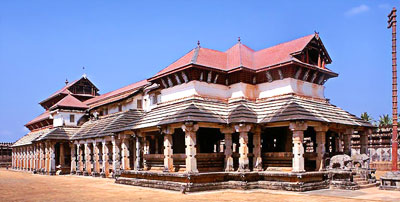 Mudabidri developed as a center of Jain religion during 14th and 15th centuries. This is the center where culture, art and architecture of the ancient India developed. Being the religious center of the Jains 18 temples were built. The Jain Math, Mudabidri is presided by a Bhattaraka of the Mula Sangh order. The famous basadis located here are Guru basadi, Tribhuvana Tilaka Chudamani Basadi and Ammanavara Basadi.
Mudabidri developed as a center of Jain religion during 14th and 15th centuries. This is the center where culture, art and architecture of the ancient India developed. Being the religious center of the Jains 18 temples were built. The Jain Math, Mudabidri is presided by a Bhattaraka of the Mula Sangh order. The famous basadis located here are Guru basadi, Tribhuvana Tilaka Chudamani Basadi and Ammanavara Basadi.
Guru basadi is the oldest Jain monument in Mudabidri. The temple houses a stone statue of Pareshnatha. This idol is around 3.5 meters in height and is installed in the sanctum of Guru basadi. The rare Jain palm leaf manuscripts are preserved here. This basadi is the apt place if one wants to know about the early Jain culture and its history. Thus apart from being religious center it is also an interesting historical site.
Another attraction here is Tribhuvana Tilaka Chudamani basadi. This is the largest and the most flamboyantly designed Jain temples of Mudabidri. The natives there also refer to it as Thousand Pillared temple or Savira Kambada Basadi. This granite temple was built in 1430 A.D. The 2.5 meters bronze figure of Lord Chandranatha Swami in the sanctum of this basadi is considered to be holy. This 3-storied building was built with the contributions from the then rulers, the Jain Bhattaraka Swamiji, merchants and the common people. The striking feature of this temple is the open pillared hall comprising of elaborately designed pillars in Vijayanagara style. Manastambha, 15 mt. tall stone pillar stands in front of the Tribhuvana Tilaka Chudamani basadi in Mudabidri.
Mudabidri was also the place of the Chowtas, a Jain ruling family. They were originally situated at Puthige, about 5 km from Mudabidri. However, in the 17th century they shifted their capital here. The ruins of the 17th century Chowta Palace are famous for its beautiful carvings on the wooden pillars and ceilings. There are wonderful idols of Jain Trirthankar, Yakshas and Yakshis in the Jain basadis of Mudabidri. The stucco images in the Leppada basadi and Ammanavara Basadi are a visual treat.
Jain literature also flourished in Mudabidri. Ratnakara Varni, author of Bharatesha Vaibhava belonged here. The famous Jain canonical texts, Dhavala texts, are to be found in these monasteries. These manuscripts along with the palm leaf ones are of great historical significance. The Mughal invasions on Mudabidri, Karnataka were quite common. As a result the ancient Jain texts were shifted to Mudbidri from Shravanabelagola. Digambara traditions are elaborately explained in these texts. There is a Jain Math near the main temple. It has a library that contains the texts dating back to 12th and 13th centuries.
Mudabidri is the just the right place for the historians and also for the travellers who has an interest to know more about the Jain traditions. Till date all the festivals, customs and traditions of the Jain community are followed here. This place is considered one of the holiest places in Karnataka and is often referred as the `Jain Varanasi.` Mudabidri in Karnataka is accessible from Bangalore and Mangalore.




















